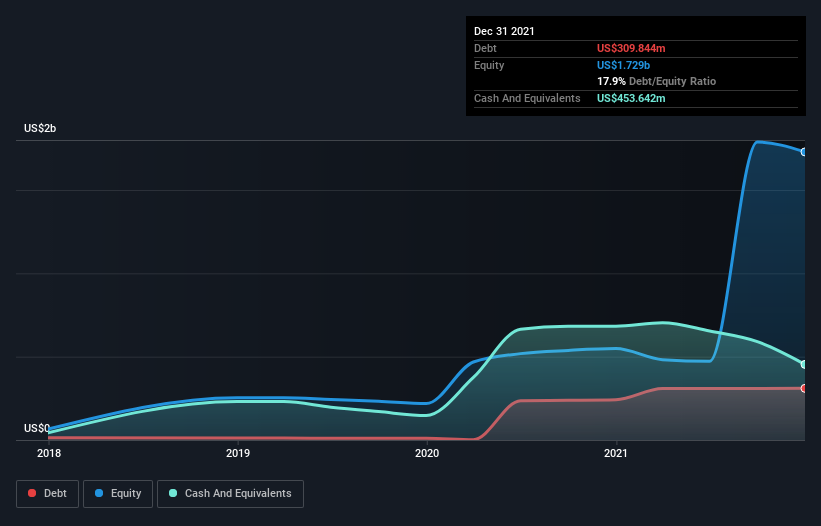- United States
- /
- Healthcare Services
- /
- NasdaqGS:ONEM
Is 1Life Healthcare (NASDAQ:ONEM) Weighed On By Its Debt Load?
Warren Buffett famously said, 'Volatility is far from synonymous with risk.' So it seems the smart money knows that debt - which is usually involved in bankruptcies - is a very important factor, when you assess how risky a company is. As with many other companies 1Life Healthcare, Inc. (NASDAQ:ONEM) makes use of debt. But should shareholders be worried about its use of debt?
What Risk Does Debt Bring?
Debt is a tool to help businesses grow, but if a business is incapable of paying off its lenders, then it exists at their mercy. Part and parcel of capitalism is the process of 'creative destruction' where failed businesses are mercilessly liquidated by their bankers. However, a more common (but still painful) scenario is that it has to raise new equity capital at a low price, thus permanently diluting shareholders. Of course, debt can be an important tool in businesses, particularly capital heavy businesses. When we examine debt levels, we first consider both cash and debt levels, together.
See our latest analysis for 1Life Healthcare
What Is 1Life Healthcare's Net Debt?
As you can see below, at the end of December 2021, 1Life Healthcare had US$309.8m of debt, up from US$241.2m a year ago. Click the image for more detail. However, its balance sheet shows it holds US$453.6m in cash, so it actually has US$143.8m net cash.

How Strong Is 1Life Healthcare's Balance Sheet?
The latest balance sheet data shows that 1Life Healthcare had liabilities of US$202.1m due within a year, and liabilities of US$696.3m falling due after that. On the other hand, it had cash of US$453.6m and US$103.5m worth of receivables due within a year. So its liabilities total US$341.3m more than the combination of its cash and short-term receivables.
Of course, 1Life Healthcare has a market capitalization of US$2.05b, so these liabilities are probably manageable. Having said that, it's clear that we should continue to monitor its balance sheet, lest it change for the worse. While it does have liabilities worth noting, 1Life Healthcare also has more cash than debt, so we're pretty confident it can manage its debt safely. There's no doubt that we learn most about debt from the balance sheet. But it is future earnings, more than anything, that will determine 1Life Healthcare's ability to maintain a healthy balance sheet going forward. So if you're focused on the future you can check out this free report showing analyst profit forecasts.
In the last year 1Life Healthcare wasn't profitable at an EBIT level, but managed to grow its revenue by 64%, to US$623m. With any luck the company will be able to grow its way to profitability.
So How Risky Is 1Life Healthcare?
We have no doubt that loss making companies are, in general, riskier than profitable ones. And we do note that 1Life Healthcare had an earnings before interest and tax (EBIT) loss, over the last year. And over the same period it saw negative free cash outflow of US$152m and booked a US$255m accounting loss. But the saving grace is the US$143.8m on the balance sheet. That kitty means the company can keep spending for growth for at least two years, at current rates. 1Life Healthcare's revenue growth shone bright over the last year, so it may well be in a position to turn a profit in due course. Pre-profit companies are often risky, but they can also offer great rewards. The balance sheet is clearly the area to focus on when you are analysing debt. However, not all investment risk resides within the balance sheet - far from it. For example 1Life Healthcare has 4 warning signs (and 1 which is potentially serious) we think you should know about.
Of course, if you're the type of investor who prefers buying stocks without the burden of debt, then don't hesitate to discover our exclusive list of net cash growth stocks, today.
New: AI Stock Screener & Alerts
Our new AI Stock Screener scans the market every day to uncover opportunities.
• Dividend Powerhouses (3%+ Yield)
• Undervalued Small Caps with Insider Buying
• High growth Tech and AI Companies
Or build your own from over 50 metrics.
Have feedback on this article? Concerned about the content? Get in touch with us directly. Alternatively, email editorial-team (at) simplywallst.com.
This article by Simply Wall St is general in nature. We provide commentary based on historical data and analyst forecasts only using an unbiased methodology and our articles are not intended to be financial advice. It does not constitute a recommendation to buy or sell any stock, and does not take account of your objectives, or your financial situation. We aim to bring you long-term focused analysis driven by fundamental data. Note that our analysis may not factor in the latest price-sensitive company announcements or qualitative material. Simply Wall St has no position in any stocks mentioned.
About NasdaqGS:ONEM
1Life Healthcare
1Life Healthcare, Inc. operates a membership-based primary care platform under the One Medical brand.
Mediocre balance sheet with concerning outlook.
Similar Companies
Market Insights
Community Narratives




